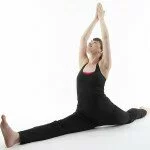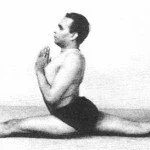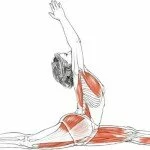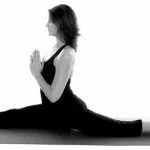Hanumanasana (Sanskrit: हनुमानासन) or Monkey Pose is an asana.
The name comes from the Sanskrit words Hanuman (a divine entity in Hinduism who resembles a monkey) and asana (posture) and commemorates the giant leap
made by Hanuman to reach the Lankan islands from the mainland of India.
This asana is of utmost spiritual significance, as well as requiring significant physical flexibility. It stretches the hamstrings and groin.
Step by Step:-
- Kneel on the floor. Step your right foot forward about a foot in front of your left knee, and rotate your right thigh outwardly. Do this by lifting the inner sole away from the floor and resting the foot on the outer heel.
- Exhale and lean your torso forward, pressing your fingertips to the floor. Slowly slide your left knee back, straightening the knee and at the same time descending the right thigh toward the floor. Stop straightening the back knee just before you reach the limit of your stretch.
- Now begin to push the right heel away from your torso. Because we started with a strong external rotation of the front leg, gradually turn the leg inward as it straightens to bring the kneecap toward the ceiling. As the front leg straightens, resume pressing the left knee back, and carefully descend the front of the left thigh and the back of the right leg (and the base of the pelvis) to the floor. Make sure the center of the right knee points directly up toward the ceiling.
- Also check to see that the back leg extends straight out of the hip (and isn’t angled out to the side), and that the center of the back kneecap is pressing directly on the floor. Keep the front leg active by extending through the heel and lifting the ball of the foot toward the ceiling. Bring the hands into Anjali Mudra (Salutation Seal) or stretch the arms straight up toward the ceiling.
- Stay in this pose for 30 seconds to a minute. To come out, press your hands to the floor, turn the front leg out slightly, and slowly return the front heel and the back knee to their starting positions. Then reverse the legs and repeat for the same length of time.
Anatomical Focus:-
- Thighs
- Hamstrings
- Abdomen
- Groins
- Chest
- Shoulders
Therapeutic Applications:-
Sciatica
Benefits:-
- Stretches the thighs, hamstrings, groins
- Stimulates the abdominal organs
Contraindications and Cautions:-
Groin or hamstring injuries
Beginner’s Tip:-
To increase the length of the torso and spine, press the back foot actively into the floor and, from this pressure, lift the shoulder blades firmly into your back.
Variations:-
From the position described in step 4 above, lean the torso into a forward bend over the front leg and take hold of the foot with your hands. Hold for 10 to 15 seconds, then come up on an inhalation.
Modifications and Props:-
Students just beginning to learn this pose are often unable to get the legs and pelvis down on the floor, which is usually due to of tightness in the backs of the legs or front groins. While in the starting leg position then (as described in Step 1 above), place a thick bolster below the pelvis (with its long axis parallel to your inner legs). As you straighten the legs, slowly release your pelvis down onto the bolster. If the bolster isn’t thick enough to comfortably support your pelvis, add a thickly folded blanket.
Preparatory Poses:-
- Baddha Konasana
- Janu Sirsasana
- Paschimottanasana
- Prasarita Padottanasana
- Supta Virasana
- Supta Baddha Konasana
- Supta Padangustasana
- Upavistha Konasana
- Urdhva Prasarita Padasana
- Uttanasana
- Virasana
Follow-Up Poses:-
- Eka Pada Rajakapotasana
- Natarjasana
- Paschimottanasana
- Upavistha Konasana
Deepen The Pose:-
The arms are raised overhead from the “trigger” of the lower back ribs. Take the back ribs away from the top of the pelvis, and use this lift to reach the arms closer to the ceiling. Lengthen along the backs of the arms, stretching your pinkies a little closer to the ceiling than the index fingers. Then pin the fingertips against the ceiling and release or “hang” the ribs from the arms.
Yo-yo the ribs between the arms and the pelvis: relative to the pelvis, the ribs lift, boosting the arms closer to the ceiling; relative to the arms, the ribs drop toward the floor, increasing the stretch in the armpits.





